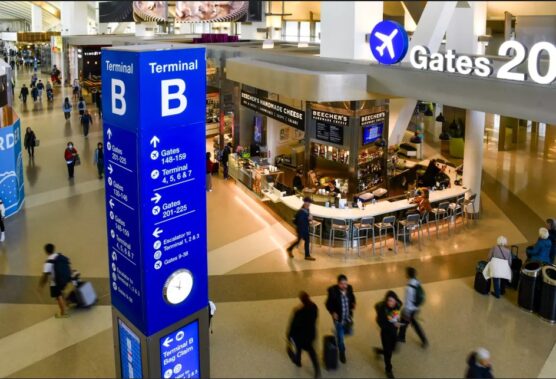The Los Angeles County Department of Public Health has been notified of one case of measles in a non-Los Angeles County resident who traveled to Los Angeles International airport while infectious at the end of November.
This person arrived on Qatar Airways flight QR 0739 at the Tom Bradley International Airport Terminal B, Gate 155 on Nov. 27.
Individuals who were at Terminal B from approximately 12:30 p.m. to 6 p.m. may be at risk of developing measles due to exposure to this traveler. In collaboration with the Centers for Disease Control, passengers assigned to specific seats that may been exposed on Qatar Airways flight QR 0739 on Nov. 27, will be notified by local departments of health. These agencies work together to investigate communicable disease exposures on international flights to the United States.
Exposed individuals should confirm if they have been vaccinated against measles. If they have not had measles in the past and have not yet obtained the measles vaccine, they are at risk of contracting measles if they have been exposed. Unimmunized persons or those with unknown immunization status who were at this location during the date and times listed above are at risk of developing measles from 7 to 21 days after being exposed. Exposed individuals who have been free of symptoms for more than 21 days (Dec. 18) are no longer at risk.
“Measles spreads easily through the air and on surfaces and easily between people who are not already protected from it,” said Muntu Davis, MD, MPH, Los Angeles County Health Officer. “A person can spread the illness to others before they have symptoms, and it can take seven to 21 days for symptoms to show up after being exposed. Measles can lead to severe disease in young children and vulnerable adults. The best way to protect yourself and your family from infection is with the highly effective measle vaccine.”
People who were in the locations above around the aforementioned times should:
Review their immunization and medical records to determine if they are protected against measles. People who have not had measles infection or received the measles immunization previously may not be protected from the measles virus and should talk with a health care provider about receiving measles, mumps and rubella (MMR) immunization.
Contact and notify their health care provider as soon as possible about a potential exposure if they are pregnant, an infant, have a weakened immune system and/or are unimmunized regardless of vaccination history.
Monitor themselves for illness with fever and/or an unexplained rash from 7 days to 21 days after their exposure (the time period when symptoms may develop).
If symptoms develop, stay at home, and avoid school, work and any large gatherings. Call a healthcare provider immediately. Do not enter a health care facility before calling them and making them aware of your measles exposure and symptoms. Public Health can assist health care providers in appropriately diagnosing and managing your care.
About Measles
Measles spreads easily through the air when an infected person breathes, talks, coughs, or sneezes. The virus can stay in the air and on surfaces for many hours, even after the infected person has left. The infected person can spread the disease up to four days before a measles rash appears and up to four days after the rash appears. If other people breathe the contaminated air or touch the infected surface, then touch their eyes, noses, or mouths, they can become infected.
Common symptoms for measles include:
High fever (higher than 101° F)
Cough
Runny nose
Red and watery eyes
Tiny white spots that may appear inside the mouth 2-3 days after symptoms begin.
Rash 3-5 days after other signs of illness. The “measles rash” typically starts at the face and then spreads down to the rest of the body.
Measles can be prevented with a measles, mumps, and rubella vaccine (MMR or MMRV). The MMR vaccine protects against three diseases: measles, mumps and rubella. The MMRV vaccine protects against four diseases: measles, mumps, rubella, and varicella (chickenpox).
They are administered in two doses and are highly effective: two doses are 97% effective against measles and one dose is 93% effective. The spread of measles can be prevented if 2-dose coverage of vaccine remains at 95% or above in the community. For more information on measles, visit: ph.lacounty.gov/measles.
Most health insurances cover the cost of the MMR and MMRV vaccine. Insured persons should check with their doctor or local pharmacy to see what vaccines are offered. Uninsured or underinsured children and adults can access free or low-cost vaccines at clinics enrolled in the Vaccines for Children (VFC) and Vaccines for Adults (VFA) program.
For a list of clinics that offer free or low-cost immunizations for persons who are uninsured or underinsured, call 2-1-1 or visit: http://publichealth.lacounty.gov/ip/clinics.htm.
In the United States, as of Nov. 21, a total of 280 measles cases have been reported this year, which is more than double the number of cases reported in all of 2023.
Furthermore, 40% of these cases required hospitalization for management of measles complications or isolation. Most of these cases have been unimmunized. In Los Angeles County, there was one previous case of measles reported in February.
Like this:
Like Loading...
Related





 Tweet This
Tweet This Facebook
Facebook Digg This
Digg This Bookmark
Bookmark Stumble
Stumble RSS
RSS




























REAL NAMES ONLY: All posters must use their real individual or business name. This applies equally to Twitter account holders who use a nickname.
0 Comments
You can be the first one to leave a comment.